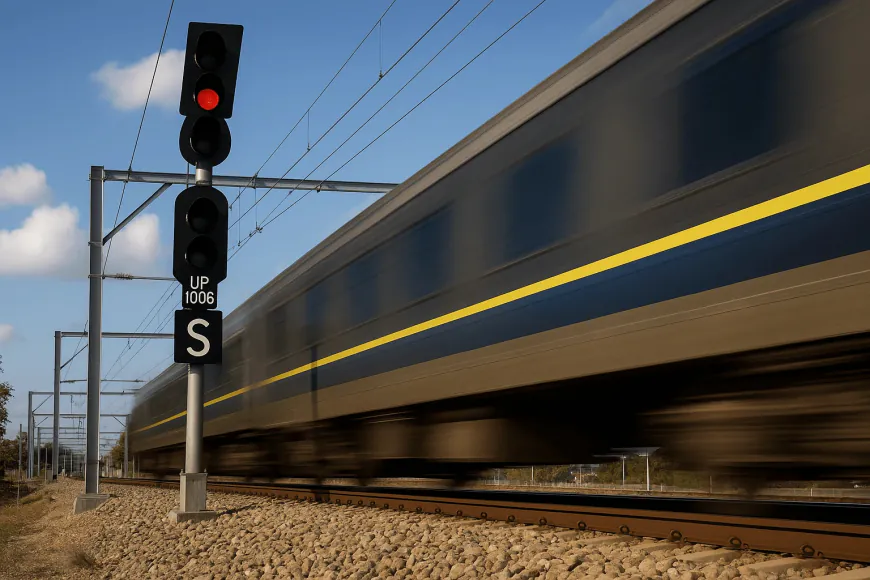Alstom Transforms New Zealand's Rail Network with Advanced Traffic Management System
Alstom delivers state-of-the-art Iconis traffic management system to KiwiRail, reducing delays by 30% and saving 20% energy. First deployment on Wairarapa line marks New Zealand's rail digital transformation.

Alstom, the global leader in smart and sustainable mobility solutions, has successfully delivered its cutting-edge Iconis traffic management system to KiwiRail, marking a significant milestone in the digital transformation of New Zealand's national rail network. The innovative system went live on the Wairarapa line on Saturday, May 3rd, representing the first step in a comprehensive modernization program that will eventually extend across the entire country.
Revolutionary Digital Rail Management Solution Deployed in New Zealand
The implementation of Alstom's Iconis platform introduces unprecedented capabilities to KiwiRail's operations, bringing New Zealand into alignment with over 30 countries worldwide that have already embraced this advanced technology. Operating from two centralized control centers in Wellington and Auckland, the system provides operators with real-time network visibility and intelligent decision-making tools that dramatically enhance both operational efficiency and passenger experience.
"This technology marks the beginning of a new digital era for KiwiRail," stated Pascal Dupond, Alstom Australia and New Zealand Managing Director. "New Zealand now joins more than 30 countries benefiting from our proven solutions. The exceptional collaboration with KiwiRail throughout this project has been instrumental in achieving this successful deployment."
Comprehensive Rail Network Optimization Through Digital Integration
The Iconis system, now known commercially as Onvia Vision, represents a paradigm shift in how rail networks are managed and operated. By integrating previously disparate systems into a unified digital platform, KiwiRail gains unprecedented oversight and control capabilities across multiple operational domains:
- Enhanced signaling operations with real-time monitoring and response
- Improved network safety through automated hazard detection and prevention
- Optimized traffic management with intelligent routing and scheduling
- Streamlined maintenance planning using predictive analytics
- Real-time passenger information delivery across multiple channels
This integrated approach replaces traditional manual processes with data-driven operations, enabling control center personnel to anticipate potential traffic disruptions before they occur and implement optimal solutions with minimal service impact.
Phased Implementation Strategy Ensures Smooth Transition
The Wairarapa line activation serves as the pilot deployment, allowing KiwiRail to progressively expand the system to additional regions following a carefully structured rollout plan. This methodical approach ensures that operational teams can fully adapt to the new technology while maintaining uninterrupted service across the network.
"We've designed the implementation process to maximize knowledge transfer at each stage," explained a senior Alstom project manager. "Our team will provide comprehensive support, training, and maintenance throughout each deployment phase, ensuring KiwiRail personnel develop complete mastery of the system's capabilities."
The long-term support arrangement between Alstom and KiwiRail underscores both organizations' commitment to sustainable technology adoption, with ongoing collaboration extending well beyond the initial installation period.
Measurable Performance Improvements Drive Business Value
The Alstom Iconis solution has established an impressive track record across its global installations, consistently delivering quantifiable operational benefits:
- 10-30% reduction in train delays through proactive congestion management
- Up to 20% energy savings via optimized acceleration/deceleration profiles
- Increased network capacity without additional infrastructure investment
- Enhanced customer satisfaction through improved punctuality and information
These performance improvements translate directly into business advantages for railway operators, with KiwiRail positioned to realize similar benefits as the system reaches full implementation across New Zealand's rail network.
Future-Proofing New Zealand's Rail Infrastructure
Carl Mills, KiwiRail Project Director, emphasized the strategic importance of this technological upgrade: "This system future-proofs our network for anticipated growth in both passenger numbers and freight volumes. It offers a truly transformative experience for our operational staff while delivering significantly better service for our passengers and commercial clients."
The implementation comes at a critical time for New Zealand's transportation sector, with increasing emphasis on sustainable mobility solutions to reduce carbon emissions and alleviate road congestion. By enhancing the efficiency and attractiveness of rail transport, the Iconis system directly supports national environmental and transportation policy objectives.
"Our partnership with Alstom is founded on mutual trust, transparency, and a shared commitment to excellence in commercial service," Mills added. "Together, we're building a railway fit for New Zealand's future mobility needs."
Building on Decades of Global Expertise
The Iconis platform, which equips over 70 mainline control centers across more than 20 countries worldwide, represents the culmination of more than three decades of continuous development and operational refinement. This extensive deployment history provides KiwiRail with the confidence that comes from implementing a thoroughly proven solution with demonstrated reliability in diverse operating environments.
As a core component of Alstom's comprehensive digital mobility portfolio, the system continues to evolve, incorporating the latest advances in artificial intelligence, predictive analytics, and cybersecurity. The modular architecture ensures KiwiRail can adopt future enhancements without disrupting established operations.
Digital Transformation Driving Passenger and Freight Excellence
The digitalization of New Zealand's rail network arrives amid growing recognition of rail transport's strategic importance in addressing climate change concerns while meeting increasing mobility demands. By improving service reliability and operational efficiency, the Iconis implementation strengthens rail's competitive position against less sustainable transportation modes.
For passengers, the most visible benefits will include more punctual services, better real-time information during journeys, and smoother connections between different transport modes. Freight customers will benefit from improved scheduling precision and enhanced capacity utilization, enabling more goods to move by rail rather than road.
This technological leap forward positions New Zealand's rail network among the world's most advanced, creating a foundation for continued innovation in how people and goods move throughout the country. As the system expands beyond the initial Wairarapa deployment, its transformative impact on the nation's transportation ecosystem will continue to grow.
"What we're witnessing is more than just a technology upgrade," concluded Pascal Dupond. "It's the beginning of a new chapter in New Zealand's transportation story—one defined by intelligence, sustainability, and exceptional service quality."


 TrainsNews
TrainsNews 





